|
|
|
Sort Order |
|
|
|
Items / Page
|
|
|
|
|
|
|
| Srl | Item |
| 1 |
ID:
120026
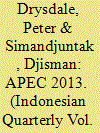

|
|
|
| 2 |
ID:
121862
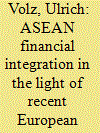

|
|
|
|
|
| Publication |
2013.
|
| Summary/Abstract |
This article reflects on the ambitions of the Association of Southeast Asian Nations (ASEAN) to foster regional economic and financial integration among its member countries against the backdrop of the European financial crisis. Based on a review of the European experiences with financial integration since the 1970s, this article critically examines the potential risks associated with the creation of a financially integrated ASEAN Economic Community and the implications for policy autonomy of ASEAN members. It outlines the regulatory and institutional requirements that need to be put in place in order to minimize financial stability risk if an integrated financial sector across ASEAN is aimed for.
|
|
|
|
|
|
|
|
|
|
|
|
|
|
|
|
| 3 |
ID:
094384


|
|
|
|
|
| Publication |
2010.
|
| Summary/Abstract |
This paper examines whether reforms have created a substantial commercial sector with market characteristics in China's financial system. Many studies conclude that the operation of China's capital markets lacks market features, resulting in fragmentation. Yet, this lack of integration coincides with rapid and continuous economic growth. We study the dynamic pattern of domestic capital mobility with a unique data set on provincial savings and investment, which allows us to examine components as well as aggregates. After stripping out foreign and officially influenced funds, we find that the behavior of capital flows in what we define as China's commercial sector looks increasingly like that of interstate flows in the US and other advanced nations. Tracking the direction and size of capital flows also highlights the different behavior of commercial and non-commercial funds transfers in China. This result undercuts the widespread view of China's economy as lacking domestic integration.
|
|
|
|
|
|
|
|
|
|
|
|
|
|
|
|
| 4 |
ID:
106403


|
|
|
|
|
| Publication |
2011.
|
| Summary/Abstract |
Recent literature suggests the extent of foreign listings (cross-listings) on domestic stock exchanges may be informative as a measure of financial integration. In this study, we present both stylized facts and panel data analysis examining relationships between the proportion of foreign listings and other measures of integration in a sample of Asian markets to determine if this form of cross-listing complements or substitutes for other aspects of integration. We find that higher trade openness, higher output growth and lower inflation are associated with a greater proportion of foreign listings. In addition, we find that FDI openness has a negative relationship to the proportion of foreign listings, suggesting that these aspects of financial integration are substitutes. For policymakers, our results indicate that unless the appropriate financial liberalisation policies are in place, countries may find it difficult to simultaneously attract foreign listings to enhance development of their stock market and to grow their real economy through FDI.
|
|
|
|
|
|
|
|
|
|
|
|
|
|
|
|
| 5 |
ID:
117711
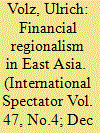

|
|
|
|
|
| Publication |
2012.
|
| Summary/Abstract |
This article provides an overview of the current state of financial regionalism in East Asia and discusses why and how the East Asian countries should go forward in terms of financial and monetary regionalism. It highlights intra-regional exchange rate stability as an important regional public good and makes the case for greater exchange rate cooperation. To this end, East Asian countries should gradually reduce their exposure to the US dollar and move towards currency basket regimes which would sustain relative intra-regional exchange rate stability while allowing for sufficient flexibility to accommodate idiosyncratic shocks. Against the backdrop of the global and European financial crisis, the article also urges a reconsideration of the costs and benefits of international - and regional - financial integration and calls for a further strengthening of East Asia's regional financial architecture.
|
|
|
|
|
|
|
|
|
|
|
|
|
|
|
|
| 6 |
ID:
138117
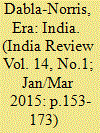

|
|
|
|
|
| Summary/Abstract |
India experienced unprecedented growth during the past two decades against the backdrop of wide-ranging “first generation” of reforms, growing trade and financial integration, buoyant external demand, and ample global liquidity. Like other emerging markets (EMs), India also enjoyed a good measure of macroeconomic resilience, evidenced by the fact that the Indian economy rebounded from the global financial crisis much sooner and faster than advanced and indeed, many other emerging market economies.
|
|
|
|
|
|
|
|
|
|
|
|
|
|
|
|
| 7 |
ID:
170516


|
|
|
|
|
| Summary/Abstract |
This paper analyzes the banking systems of the founding states of the Eurasian Economic Union (EAEU) to indentify discrepancies that may hinder the establishment of a single market for financial services. Practical contributions are derived from two dimensions. First, a comparison of the EAEU banking sectors’ structures prior to integration reveals common features such as high concentration, low level of foreign ownership and dominance of state-controlled banks. Significant heterogeneity in the development of the EAEU banking sectors, however, is observed. We expect changes towards reinforced Russian banks’ power in smaller EAEU member states. Intense cross-border competition will drive a further consolidation of domestic credit institutions and decrease the market share of state banks. Second, harmonization of banking regulations and supervisory practices is a critical starting point for moving to a single market for financial services. We report some divergences in the implementation of Basel III standards at the national levels. Russian banks’ regulatory framework is more advanced and compliant with international requirements for capitalization and liquidity. Governance and information disclosure in the EAEU banking sectors, however, remain weak. Unless regulation is strengthened and appropriate prudential tools to control bank risks are properly set, financial integration may facilitate spillover of risks across national borders and threaten the financial stability in the EAEU.
|
|
|
|
|
|
|
|
|
|
|
|
|
|
|
|
| 8 |
ID:
106003
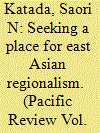

|
|
|
|
|
| Publication |
2011.
|
| Summary/Abstract |
After the devastating experience of the Asian financial crisis more than ten years ago, East Asia launched regional economic cooperation efforts. East Asia's mixed response to the global financial crisis a decade later, however, reveals how certain impetuses that gave rise to unified efforts to regional institution building in East Asia at the time of the AFC derived, fundamentally, from the region's defensive desire as it positioned itself within the harsh global economic and political environment of that time. The GFC triggered reorganization of global economic governance by discrediting neoliberal principles, introducing a new global governance structure and allowing reliance of domestic stimuli for economic recovery. Those shifts, in turn, led to the loss of East Asia's basic mandate towards regional cooperation. In other words, the focus of solving the region's economic vulnerability has now moved from regional arrangement to national and global stages. In particular, the East Asian governments now see less of a need to counterweight the predominant neoliberal voice through unified regional voice as the expansion of the forum to discuss global economic governance to G20 and IMF reform to provide East Asia more representation.
|
|
|
|
|
|
|
|
|
|
|
|
|
|
|
|
| 9 |
ID:
117676
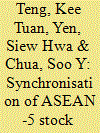

|
|
|
|
|
| Publication |
2013.
|
| Summary/Abstract |
This study explores the changing direction and degree of financial integration of the emerging economies, People's Republic of China (PRC) and India, with ASEAN-5 and compares it to the developed economies, the US and Japan, in a time-varying framework. The concordance and rolling concordance indices are used to study the cyclical behaviour in the ASEAN-5 stock markets with the economic activity of the emerging and developed economies. This study covers the period between January 1991 and June 2010. One of the more significant findings from this study is that ASEAN-5 stock markets do not react as a whole to external shock from these four trading partners. Each stock market in ASEAN-5 responded differently in terms of direction and degree towards the influences of the economic condition in these emerging and developed economies. The ASEAN-5 stock markets were less correlated with economic activities in emerging economies but were more aligned with economic activities in developed economies. In summary, ASEAN-5 stock market cycles were still more dependent on the developed economies' growth rate cycles.
|
|
|
|
|
|
|
|
|
|
|
|
|
|
|
|
| 10 |
ID:
142892


|
|
|
|
|
| Summary/Abstract |
Within a year of the publication in 1987 of my historical account of the shifting priorities in Europe’s monetary and financial integration, dramatic first steps in a process of major changes in both areas were taken: In June 1988, the then 12 members states of the European Economic Community committed themselves to removing the residual controls on capital flows within a short time scale. And, in that same month, the European Council of Heads of State and Governments “confirmed the objective of progressive realization of economic and monetary union” and set up a committee, largely composed of national central bank governors, with Jacques Delors, then President of the European Commission as Chairman. The “Delors Report” of 1989 formed a stepping stone to the Maastricht Treaty, adopted at the end of 1991, and to the start of a common currency for 11 member states only seven years later. The scope and the speed of the process came as a major surprise, even to those most convinced of its net benefits, among whom this author has to be counted. Why did this strong momentum develop? And, in retrospect, would a more steady pace have been preferable?
|
|
|
|
|
|
|
|
|
|
|
|
|
|
|
|
|
|
|
|
|